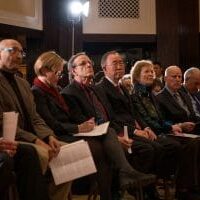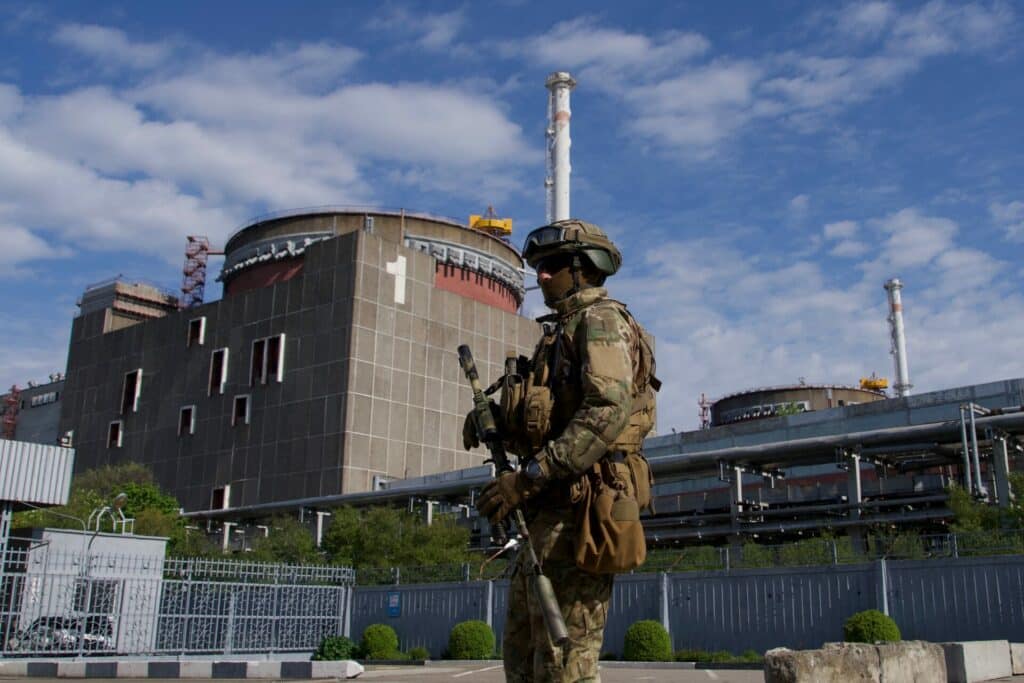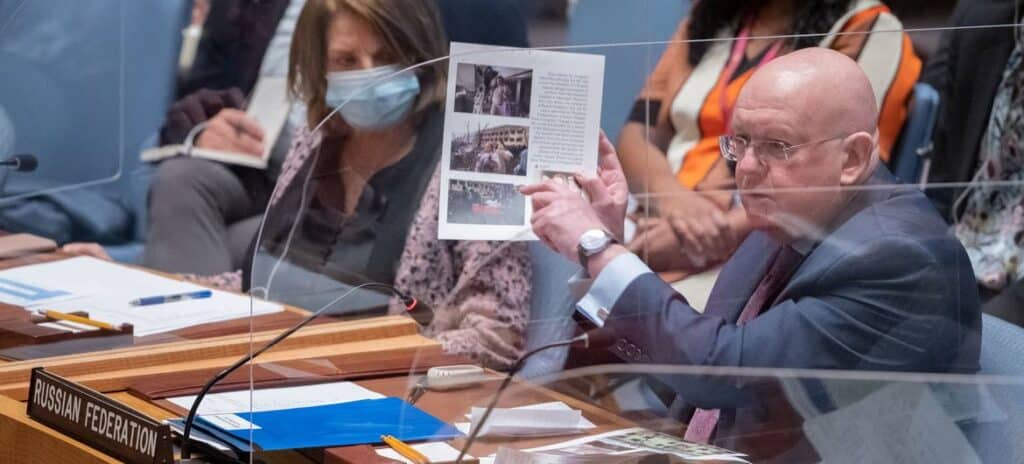Image

By Alan Earls
Nuclear war or the threat thereof is not normally the province of a local community-oriented publication but since the consequences of such things would likely impact us, and particularly, since so few people anywhere, seem the least bit concerned, we are taking it upon ourselves to speak. Growing up during the Cold War, the "Doomsday Clock" -- an attention-getting device dreamed up by the very smart folks that started the Bulletin of the Atomic Scientists -- was regular fodder for nightly news broadcasters and print editorialists. The movement of the hands on the clock a little closer to midnight, or occasionally in the other direction, drove public commentary, made for sleepless nights for millions, and bore witness to particularly nerve-racking moments like the Cuban Missile Crisis and the unsettling period in the Soviet Union just after the death of long-time strongman Leonid Brezhnev which coincided with the rise of a less conciliatory American president, Ronald Reagan.
Today it is worrying that despite the vast nuclear arsenals of the world, the "Doomsday Clock" is rarely spoken of; even more so when the clock has recently been moved closer to midnight -- and potential apocalypyse -- than at ANY time in the 70+ years of its existence. Below, we reproduce commentary from early this year from The Bulletin of the Atomic Scientists...
2023 Doomsday Clock Statement
Science and Security Board
Bulletin of the Atomic Scientists
Editor, John Mecklin
January 24, 2023
Founded in 1945 by Albert Einstein and University of Chicago scientists who helped develop the first atomic weapons in the Manhattan Project, the Bulletin of the Atomic Scientists created the Doomsday Clock two years later, using the imagery of apocalypse (midnight) and the contemporary idiom of nuclear explosion (countdown to zero) to convey threats to humanity and the planet. The Doomsday Clock is set every year by the Bulletin’s Science and Security Board in consultation with its Board of Sponsors, which includes 10 Nobel laureates. The Clock has become a universally recognized indicator of the world’s vulnerability to global catastrophe caused by manmade technologies.

This year, the Science and Security Board of the Bulletin of the Atomic Scientists moves the hands of the Doomsday Clock forward, largely (though not exclusively) because of the mounting dangers of the war in Ukraine. The Clock now stands at 90 seconds to midnight—the closest to global catastrophe it has ever been.
The war in Ukraine may enter a second horrifying year, with both sides convinced they can win. Ukraine’s sovereignty and broader European security arrangements that have largely held since the end of World War II are at stake. Also, Russia’s war on Ukraine has raised profound questions about how states interact, eroding norms of international conduct that underpin successful responses to a variety of global risks.
And worst of all, Russia’s thinly veiled threats to use nuclear weapons remind the world that escalation of the conflict—by accident, intention, or miscalculation—is a terrible risk. The possibility that the conflict could spin out of anyone’s control remains high.
Russia’s recent actions contravene decades of commitments by Moscow. In 1994, Russia joined the United States and United Kingdom in Budapest, Hungary, to solemnly declare that it would "respect the independence and sovereignty and the existing borders of Ukraine" and "refrain from the threat or use of force against the territorial integrity or political independence of Ukraine..." These assurances were made explicitly on the understanding that Ukraine would relinquish nuclear weapons on its soil and sign the Nuclear Non-Proliferation Treaty—both of which Ukraine did.
Russia has also brought its war to the Chernobyl and Zaporizhzhia nuclear reactor sites, violating international protocols and risking widespread release of radioactive materials. Efforts by the International Atomic Energy Agency to secure these plants so far have been rebuffed.
 A Russian serviceman patrols the territory of the Zaporizhzhia Nuclear Power Plant on May 1, 2022. The Zaporizhzhia Nuclear Power Plant in southeastern Ukraine is Europe's largest and among the 10 largest in the world. (Editor's note: This picture was taken during a media trip organized by the Russian army.) Photo by Andrey Borodulin/AFP via Getty Images
A Russian serviceman patrols the territory of the Zaporizhzhia Nuclear Power Plant on May 1, 2022. The Zaporizhzhia Nuclear Power Plant in southeastern Ukraine is Europe's largest and among the 10 largest in the world. (Editor's note: This picture was taken during a media trip organized by the Russian army.) Photo by Andrey Borodulin/AFP via Getty ImagesAs Russia’s war on Ukraine continues, the last remaining nuclear weapons treaty between Russia and the United States, New START, stands in jeopardy. Unless the two parties resume negotiations and find a basis for further reductions, the treaty will expire in February 2026. This would eliminate mutual inspections, deepen mistrust, spur a nuclear arms race, and heighten the possibility of a nuclear exchange.
As UN Secretary-General Antonio Guterres warned in August [2022], the world has entered “a time of nuclear danger not seen since the height of the Cold War.”
The war’s effects are not limited to an increase in nuclear danger; they also undermine global efforts to combat climate change. Countries dependent on Russian oil and gas have sought to diversify their supplies and suppliers, leading to expanded investment in natural gas exactly when such investment should have been shrinking.
In the context of a hot war and against the backdrop of nuclear threats, Russia’s false accusations that Ukraine planned to use radiological dispersal devices, chemical weapons, and biological weapons take on new meaning as well. The continuing stream of disinformation about bioweapons laboratories in Ukraine raises concerns that Russia itself may be thinking of deploying such weapons, which many experts believe it continues to develop.
 At a meeting of the Security Council on March 11, 2022, Vassily Nebenzia, Russia’s ambassador to the United Nations, accused the United States and Ukraine of concealing a bioweapons program. UN Photo/Evan Schneider
At a meeting of the Security Council on March 11, 2022, Vassily Nebenzia, Russia’s ambassador to the United Nations, accused the United States and Ukraine of concealing a bioweapons program. UN Photo/Evan SchneiderRussia’s invasion of Ukraine has increased the risk of nuclear weapons use, raised the specter of biological and chemical weapons use, hamstrung the world’s response to climate change, and hampered international efforts to deal with other global concerns. The invasion and annexation of Ukrainian territory have also violated international norms in ways that may embolden others to take actions that challenge previous understandings and threaten stability.
There is no clear pathway for forging a just peace that discourages future aggression under the shadow of nuclear weapons. But at a minimum, the United States must keep the door open to principled engagement with Moscow that reduces the dangerous increase in nuclear risk the war has fostered. One element of risk reduction could involve sustained, high-level US military-to-military contacts with Russia to reduce the likelihood of miscalculation. The US government, its NATO allies, and Ukraine have a multitude of channels for dialogue; they all should be explored. Finding a path to serious peace negotiations could go a long way toward reducing the risk of escalation. In this time of unprecedented global danger, concerted action is required, and every second counts.
* * * * * * * * *
On Friday, July 14 Massachusetts Peace Action held an emergency action at noon outside Boston's Park Street Station to protest President Biden's transfer of cluster bombs into the Ukraine war. These anti-personnel pellet weapons are known to cause grievous injury to civilians, including many children. These weapons cause such widespread death and suffering that they are now banned under The Convention on Cluster Munitions by over 120 countries around the world, including the UK, France, Germany, and many other NATO countries.
A cluster munition is a weapon consisting of a dispenser from which many exploding bomblets are scattered over wide areas. The bomblets kill and maim over an area the size of several football fields. As many as 40% of these bomblets fail to explode upon launch and land on the ground, only to end up exploding and killing civilians for decades after the war is over. (Over 60,000 farmers and civilians have been killed by unexploded ordnance - much of it cluster munitions - in Vietnam, Cambodia and Laos for the past 48 years AFTER those wars ended).
The Biden Administration has begun sending cluster bombs to Ukraine. These weapons are so dangerous to civilians that they have been banned by over 120 countries around the world, including the UK, France, Germany, and many other NATO countries.
The Pentagon insists the latest US cluster munitions are more reliable and safer than in the past. Nevertheless, the 'look' of providing these weapons is not a good one.
Massachusetts Peace Action's Assistant Director, Brian Garvey asks, "Haven't we seen enough death and suffering in this war already? President Biden should be helping to negotiate an end to this terrible war in Ukraine, not escalating it by sending even deadlier weapons into this conflict."
Last month the House of Representatives voted on an Amendment to the National Defense Authorization Act to prohibit cluster bombs from being sent to the Ukraine war. It Failed in a 276 - 147 vote. Of the Massachusetts congressional delegation Representatives Richard Neal, Jim McGovern, Lori Trahan, and Rep. Ayanna Pressley voted to stop cluster munitions. House Minority Whip Katherine Clark and Representatives Jake Auchincloss (who represents Franklin), Stephen Lynch, Bill Keating, and Seth Moulton voted to allow such weapons to be sent. The 'yes' bunch were with the majority and the matter carried.
However, it is heartening that this corps of Democrats did not vote entirely in lockstep. Perhaps this is a small indicator that more robust debate on such weighty matters is possible. It is certainly a subject worthy of more attention.